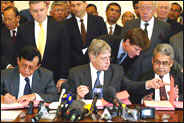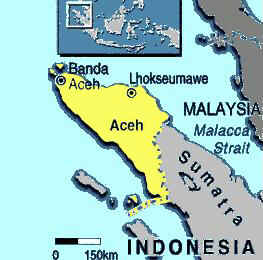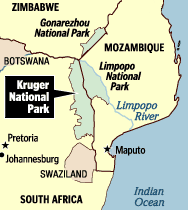Deaths
which occurred on a December 09:
2002 Some 40 persons by landslides in the beach resort
and site of the only nuclear power plant of Brazil, Angra dos Reis, after
20 cm of rain fall overnight (two months' worth of normal rainfall).
2002 Palestinian woman, 25, shot by Israeli troops firing
at the taxi in which she was going home after nightfall in violation of
a military curfew in Askar refugee camp in Nablus in the northern West Bank.
2002 Palestinian man, 28, mentally handicapped, shot by
Israeli troops near enclave settlement Einav, West Bank, when he failed
to stop as ordered.
2001 Nimr Abu Sayfien, 20, by suicide bomb he sets off prematurely
when spotted by Israeli police, at a bus stop on a busy intersection
in Haifa. Eleven persons are lightly injured. Sayfien, from Yamoun in
the northern West Bank, had planned to set off two explosions: first
a small blast, drawing rescue workers to the scene, and then a larger
bomb strapped to his body. The second bomb was defused.
2001 Marwan Subhi Jamil Abu Munis, 36, from Arraba near Jenin,
West Bank, shot by Israeli troops.
1996 Mary Leakey, 83, in Kenya, archaeologist and anthropologist.
1982 Leon Jaworski, 77, Watergate special prosecutor,
in Texas
1981 Daniel J. Faulkner, murdered,
for which Abu-Jamal would be sentenced (unjustly?)
to death
Philadelphia police officer Daniel
Faulkner (badge #4699), 25, is found dead on the street with
Mumia
Abu-Jamal, a well-known activist and occasional journalist,
lying severely wounded nearby. In 1982, Abu-Jamal
was tried for and convicted of Faulkner's murder, but because
of the murky circumstances surrounding the incident and a trial
that many believe was unfair, activists have protested that
Abu-Jamal
has been wrongly imprisoned for years.
Reportedly, Abu-Jamal,
a journalist who had been fired by National Public Radio for
his outspokenness, was driving a cab at 04:00, when he saw his
brother engaged in an altercation with Faulkner on the street.
Evidence used in the trial suggested that Abu-Jamal intervened
with a gun and then exchanged shots with Faulkner.
From the beginning, many felt
Abu-Jamal's trial was unfair. Despite the fact that he was critically
wounded, the trial began just six months after the shooting;
Abu-Jamal was so weak that he couldn't attend much of his seven-day
trial. Not only did the prosecution use nearly all of its peremptory
challenges to ensure an all-white jury, many observers felt
that Judge Albert Sabo was biased against the defendant. And
though he wanted to represent himself, the court denied him
that right, claiming that his questions to the jurors during
voir dire were intimidating.
At the end of the trial, Abu-Jamal
was sentenced to death on 3 July 1982 for first-degree murder.
Many believed that although there was a possibility that Abu-Jamal
was involved in Faulkner's death, the sentence was overly harsh
given the evidence. While in prison, Abu-Jamal has written several
books and made many radio appearances advocating an end to racism.
He has also lobbied for a new trial.
Pressure to release Abu-Jamal
from his impending execution has become stronger over time,
despite the fact that some people firmly maintain that he is
guilty. At a "Free Mumia" benefit concert featuring Rage Against
the Machine in New Jersey in 1998, a controversy erupted when
the New Jersey governor, several police organizations, and Faulkner's
widow protested. |
1979 Fulton J Sheen, 84, archbishop / religious broadcaster, in
New York City.
1971 Ralph
J Bunche, 67, Black US diplomat, 1950 Nobel Peace Prize winner,
in NYC
1968 Karl Barth, influential German theologian best known
for his commentary on Paul¹s letter to the Romans.
1952 Some 900 persons in London, choked by the Great Killer Fog
which settled on 05 December and fed by intensified millions of home coal
fires, as the temperature drops, has become worse. At last wind comes and
blows it away later in the day, but lethally affected people still die in
the coming days, until the total number of victims reaches perhaps 12'000.
Urban air pollution will never again be underestimated.
1952 Some 900 more choked by
the Great Killer Smog in London.
^top^
With weather colder than usual a fog had formed
on 05 October over London under a stagnant inversion, and loaded by
coal smoke and other pollutants had thickened by evening reducing
the visibility to a few meters. On 06 October some 500 persons died
from the smog, on 07 October another 500, and on 08 December some
900, choked by the coal smoke and industrial pollutants in the thick
smog. Before winds come at last to dissipate the smog, 900 more die
on 09 December. In the coming days, thousands more would die of the
lingering effects of the smog, and the total killed by it is estimated
to be 12'000.
Huge quantities of impurities
were released into the atmosphere during the Great Killer Smog. On
each day the following amounts of pollutants were emitted: 1000 tons
of smoke particles, 2000 tons of carbon dioxide, 140 tons of hydrochloric
acid and 14 tons of fluorine compounds. In addition, and perhaps most
dangerously, 370 tons of sulphur dioxide were converted into 800 tons
of sulphuric acid. At London's County Hall, the concentration of smoke
in the air increased from 0.49 milligrams per cubic meter on 04 December
to 4.46 on the 07 and 08 December.
Legislation followed the Great Killer
Smog of 1952 in the form of the City of London (Various Powers) Act
of 1954 and the Clean Air Acts of 1956 and 1968. These Acts banned
emissions of black smoke and decreed that residents of urban areas
and operators of factories must convert to smokeless fuels. As these
residents and operators were necessarily given time to convert, however,
fogs continued to be smoky for some time after the Act of 1956 was
passed. In 1962, for example, 750 Londoners died as a result of a
fog, but nothing on the scale of the 1952 Great Killer Smog has ever
occurred again.
Pea-soupers have become a thing of
the past in the UK, thanks partly to pollution legislation but also
to slum clearance, urban renewal and the widespread use of central
heating in the houses and offices of British towns and cities. As
recently as the early 1960s, winter sunshine totals were 30% lower
in the smokier districts of London than in the rural areas around
the capital. At the beginning of the 21st century, there is little
difference.
We should not, however, be complacent.
The air now contains other types of pollutants, many of them from
vehicle exhausts. Among these pollutants are carbon monoxide, nitrogen
dioxide, ozone, benzines and aldehydes. They are less visible than
the pollutants of yesteryear but are equally toxic, causing eye irritation,
asthma and bronchial complaints. To some extent, we have simply replaced
one form of air pollution with another. We may question whether or
not the major cities of the British Isles are any less polluted now
than they have been for hundreds of years. And there are other areas
of the world were the situation is worse. |
1939 Day 10 of Winter War: USSR
aggression against Finland. [Talvisodan
10. päivä]
More deaths due to Stalin's desire to grab Finnish territory.
First Finnish-American volunteers are on their way.
Karelian Isthmus: troops from the covering force reorganized
to form the 1st Division under the command of Major-General
Laatikainen are to assume responsibility for the eastern
section of the front in the 5th Division's defence sector
on the Karelian Isthmus.
Ladoga Karelia: the 13th Division takes up defensive positions
between Lake Ladoga and Varpajärvi.
Northern Finland: Colonel Siilasvuo's first transport arrives
at Hyrynsalmi a day late. Further north, Soviet troops finally
take the parish village at Salla.
All Soviet troops on the Finnish front are placed under
the direct command of the General Staff of the Red Army.
New York: the first detachment of Finnish American volunteers
-- about one hundred officers, pilots and mechanics -- board
ship bound for Finland.
|
1909 Red Cloud, great Sioux leader, Pine Ridge, South Dakota.
1292 Sa'di great Persian poet (Orchard, Rose Garden)
1909 Hermann Kaulbach, German artist born on 26 July 1846.
1895 (some time between 09 and 11Dec) Charles Meer Webb, British
artist born on 16 July 1830. — Relative? of James
Webb [British, C.1825-1895] ?
1879 (or 10 Dec) Jacob Albrecht Michael Jacobs, Belgian artist
born on 19 May 1812.
1870 Louise Joséphine Sarazin de Belmont, French artist born on
14 February 1790.
1715 Benedetto Gennari II, Italian painter born on 19 October
1633. — LINKS
1678 Jürgen Ovens, German painter born in 1623. — LINKS
1678 Robert Nanteuil, French engraver born in 1623. — Born
in Rheims; Studied under the engraver Regneson; moved to Paris in 1647;
became highly esteemed in Paris and made many portraits of Louis XIV
and other notables; he was named the King's engraver and received an
annual pension in 1959; died in Paris — LINKS
— 19
zoomable engravings at FAMSF (all portraits, including of Louis
XIV, Mazarin,
Colbert)
1641 Anton van Dyck, Flemish painter specialized in portraits,
born on 22 March 1599. — MORE
ON VAN DYCK AT ART “4” DECEMBER
— LINKS
— Lucas
Vorsterman — Nicolaes
van der Borght, Merchant of Antwerp — Self
portrait — Sheet
of Studies — Titian's
Self Portrait with a Young Woman — William
II, Prince of Orange and Princess Henrietta Mary Stuart, daughter of
Charles I of England — Self-Portrait
(3/4~length) —Self-Portrait
(head and shoulders) — Portrait
of a Lady — Marie
Claire de Croy, Duchess d'Havre, and Girl — Engravings
of 32 portraits at FAMSF — Margareta
Snyders — Samson
and Delilah — The
Crowning with Thorns — St.
Martin Dividing His Cloak — Frans
Snyders — Family
Portrait — Self-Portrait
— Thomas
Howard, 2nd Earl of Arundel — George
Gage, Looking at a Statuette — Cardinal
Bentivolo — Lucas
van Uffeln — Elena
Grimaldi, Marchesa Cattaneo — Paola
Adorno, Marchesa Brinole-Sale with Her Son — Giovanni
Vincenzo Imperiale —Susanna
and the Elders — Portrait
of Maria Louisa de Tassis —
Philippe Le Roy — Marie
de Raet, Wife of Philippe Le Roy — Prince
Rupert von der Pfalz — Queen
Henrietta Maria. — Equestrian
Portrait of Charles I, King of England with Seignior de St. Antoine
— Queen
Henrietta Maria with Sir Jeffrey Hudson — Charles
I, King of England, at the Hunt — Charles
I, King of England — Charles
I, King of England, from Three Angles — Children
of Charles I — Equestrian
Portrait of Charles I, King of England — Philip,
Lord Wharton — George
Villiers, 2nd Duke of Buckingham and His Brother Lord Francis Villiers
— Thomas
Howard, 2nd Earl of Arundel and Surrey with His Grandson Lord Maltravers
— James
Stuart, Duke of Lennox and Richmond — Lord
John Stuart and His Brother Lord Bernard Stuart — George
Digby, 2nd Earl of Bristol and William Russell, 1st Duke of Bedford
— Princess
Mary Stuart and Prince William of Orange
1554 (some day between 09 and 22 Dec) Alessandro Bonvicino Moretto
da Brescia, Italian artist born in 1498. — MORE
ON MORETTO AT ART “4” DECEMBER —
LINKS
— Allegory
of Faith — St
Justina with the Unicorn — Portrait
of a Man — Pietà
— The
Virgin of Carmel |
 On
a December 09:
On
a December 09:

 Births
Births